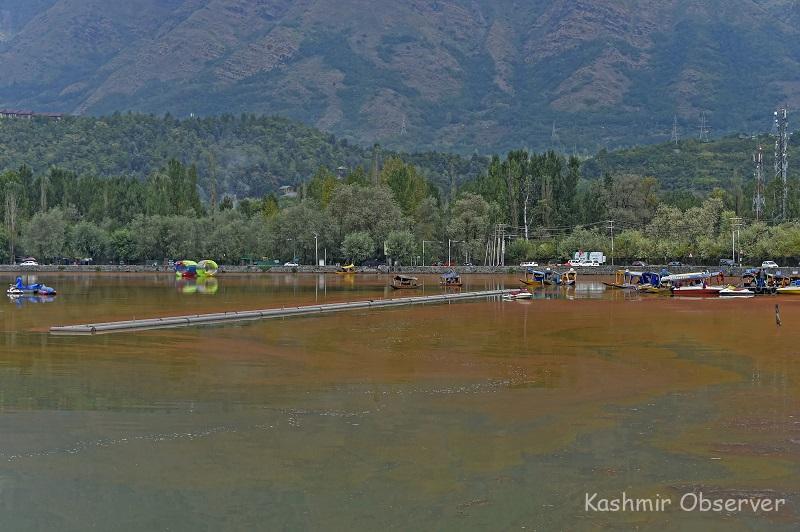(MENAFN- Kashmir Observer) Srinagar- Much to the disappointment of tourists and the inhabitants, a major portion of the famed Dal Lake has been badly affected by red algae bloom, changing the appearance of the splendid water body.
The part of the lake from Nehru Park to Mughal garden Nishat, has been badly affected by“eutrophication,” an ageing process of aquatic ecosystems.
In contrast to the assertions made by environmentalists, who linked the issue with rising pollution levels in Dal Lake, authorities defined the red algae as a natural phenomenon that will end on its own a few days after its occurrence.
ADVERTISEMENT
Ajaz Rasool, a well-known environmentalist asserted that protecting Dal Lake from pollution is the best way to prevent red algae blooms in the future.
He said the sewage-derived nutrients have a key role in the algal bloom, which is green in the morning and turns brick red with the rise in day temperature.
Read Also LG Joins Citizen-led Cleanliness Drive at Dal Lake Dal, Nigeen Lakes To Get New Lease Of Life With Floating Sewage Treatment Plants “The primary cause of the issue is the growing pollution in Dal Lake; it is not a natural occurrence and the only way I think to prevent red algal bloom is to keep Dal Lake clean,” Ghulam Rasool told Kashmir Observer.
He claimed that diffused aeration enhances water quality from the ground up while the dweeding or dredging process severely affects the lake bed.
“Diffused aeration is a shore-mounted compressor, weighted air lines, and submerged diffuser assembly that makes up the conventional system. On the lake's bottom, these diffusers are resting in one or more sites. This will certainly enhance water quality and prevent red algal from reoccurring,” he added.
Manzoor Ahmad, a Dal dweller, blamed the Lakes Conservation Management Authority (LCMA) for the mess, alleging that the agency never took the problems with delicate nature seriously, thus endangering the beautiful water body.
“First of all, we need to figure out who is poisoning Dal Lake-Dal residents or hotel owners along Boulevard Road. The same is seen from coasts where red algal has surfaced, and those who reside in Dal Lake cannot be its killers, he added.
Ajaz Rasool, however, said that red algal blooms occur in the summer and slow down in the winter when the daytime temperature falls below normal.
“Red algal resurfaced first in 1990 and then in the year 2018 again after the diffused aeration system was removed. See the more you go with dweeding, the more it affects the lake bed. Apart from maintaining cleanliness, I think aeration is the only weapon to combat algae bloom in Dal Lake,” he added.
Chairman of the Nigeen Lake Conservation Organization (NLCO), Manzoor Ahmad Wangnoo said that Pollution in Dal Lake is the outcome of human activity. He also claimed that problems like red algal blooms will persist as long as Dal Lake is contaminated.
“Dal Lake must be cleaned from one end to another for the water to flow smoothly and to significantly lessen the risks of red algae in the future,” Wangnoo said.
“I believe that only people are to be blamed for the problem being instrumental in continuously poisoning the water body. You can see that human interference has caused springs and rivulets to dry up,” he added.
Vice-Chairman Lakes Conservation Management Authority (LCMA), Bashir Ahmad Bhat said the Red algal bloom is a natural process that would cease on its own in the next four to five days.
“Red algae bloom occurs in dead pockets, so it's not a serious issue and won't have any impact on Dal Lake at all,” Bhat said, adding, the department has taken a slew of measures to deal with the issue of less concern.
He said the department has installed aerators at several locations in the lake and that the same will help contain reoccurrences of red algal in Dal Lake.
“Red algal is quite a natural process, it surfaces mainly in the summer season when day temperatures go high and lessen with the onset of winter. It's not an issue of major concern,” he added.
Follow this link to join our WhatsApp group : Join Now
























Comments
No comment